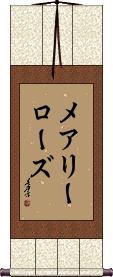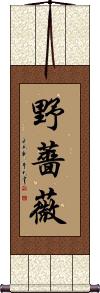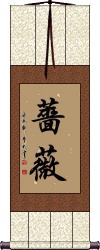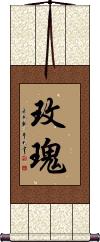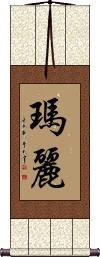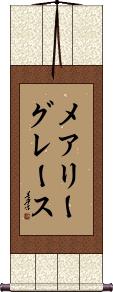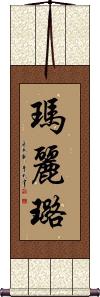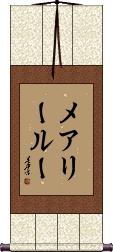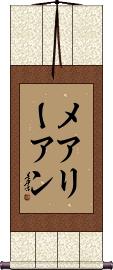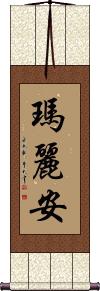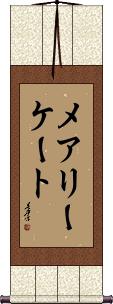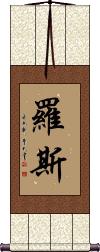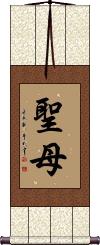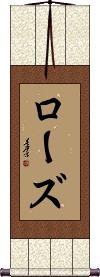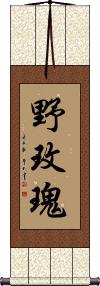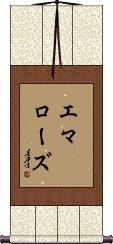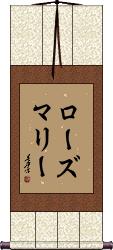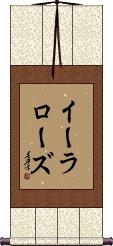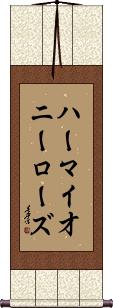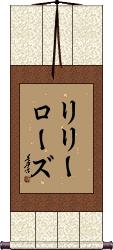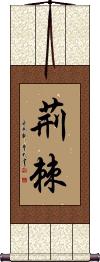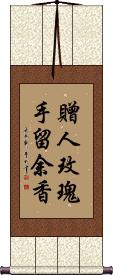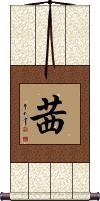Many custom options...
And formats...

The name Mary-Rose in Chinese / Japanese...
Buy a Mary-Rose calligraphy wall scroll here!
Personalize your custom “Mary-Rose” project by clicking the button next to your favorite “Mary-Rose” title below...
1. Mary-Rose
2. Rose
3. Rose Flower
4. Mary
5. Mary-Grace
6. Mary-Lou
7. Mary-Grace
8. Mary-Lou
9. Mary-Ann
10. Mary-Jane
11. Mary-Kate
12. Rose
14. Rose
15. Wild Rose
16. Emma-Rose
17. Rose-Marie
18. Emma-Rose
19. Iyla-Rose
20. Eliza-Rose
21. Iyla-Rose
22. Eliza-Rose
23. Hermione-Rose
24. Daina-Rose
25. Hermione-Rose
26. Rose-Marie
27. Lily-Rose
28. Thorns / Bramble / Briar Patch / Wild Rose
29. Rose Flowers Given, Frangrance Remains on Hands of Giver
30. Rosemarie
31. Axl
33. Madder
Mary-Rose
Mary-Rose
Rose
(Name used in botany and some poems)
野薔薇 is both the technical term for rose in the science of botany. However, it also means wild rose and can be found in some forms of poetry as well.
If you are wondering, this word for rose sounds good in Chinese, not like a super-technical such as the Latin words we use for scientific terms in the west).
Rose Flower
(The flower of love)
薔薇 is the universal way to write rose (as in the flower) because it is understood in both Chinese and Japanese (same characters in either language). 薔薇 is also a common way to write about roses in Asian poetry. This can be translated as “wild rose” if you are looking for that title.
薔薇 is also how to write “rose” in old Korean Hanja (though they now use Hangul, and most Koreans of this generation will not be able to read this without a dictionary).
Rose Flower
(The flower of love)
Mary
Mary
Mary-Grace
Mary-Lou
Mary-Grace
Mary-Lou
Mary-Ann
Mary-Ann
Mary-Jane
Mary-Jane
Mary-Kate
Mary-Kate
Rose
Holy Mother / Saint Mary
聖母 is the title for the Holy Mother, Madonna, or Virgin Mary used by Catholic Chinese, Korean, and Japanese people.
I think this would be a very cool wall scroll for a devout Catholic who also appreciates Asian artwork and language.
Note: Koreans often put a third character after these two, which creates a title that means “Hail Mary”; however, this character is not added or used in the same way in Japanese or Chinese. If you want that Korean title, just let me know, and we'll add that character for you. The two-character title shown to the left is universal, so I think it's the best choice.
Rose
Wild Rose
野玫瑰 is the simplest way to write “wild rose” in Chinese.
The first word literally means wild. The second is the single-character form of rose or roses (plural or singular is not specified in Chinese characters). This can also be translated as “sweet briar.”
Emma-Rose
Rose-Marie
Emma-Rose
Iyla-Rose
Eliza-Rose
Iyla-Rose
Eliza-Rose
Hermione-Rose
Daina-Rose
Hermione-Rose
Rose-Marie
Lily-Rose
Lily-Rose
Thorns / Bramble / Briar Patch / Wild Rose
Rose Flowers Given, Frangrance Remains on Hands of Giver
赠人玫瑰手留余香 is a proverb that has been translated several ways:
1. Roses given, fragrance in hand.
2. You present others roses, and the fragrance remains.
3. The fragrance of the rose always remains on the hand of those that bestow them.
4. A little bit of fragrance always clings to the hands which gives the flowers
However, this literally translates as “Give someone rose flowers, [your] hands keep [the] remaining fragrance.”
Rosemarie
Legendary Phoenix
鳳凰 is the word that translates as “Legendary Phoenix” in Chinese.
This refers to the bird that, according to Chinese folklore, rose from the fiery ashes.
The phoenix and dragon are by far the most famous creatures in Chinese mythology.
Madder
茜 is the name for Rubia cordifolia, Indian madder, munjeet, Japanese madder, Rubia argyi, rose madder or red madder.
This is a flowering plant that since ancient times, the root has been used to create red, pink, and other red-hued dyes.
In Japan, this can be the surname or given names Sen, Sei, or Akane.
Flower in the Mirror, Moon on Water
鏡花水月 is an old Asian proverb that means “flowers in a mirror and the moon reflected in the lake” or “flowers reflected on a mirror and the moon reflected on the water's surface.”
Literally, 鏡花水月 reads “Mirror Flower, Water Moon.”
Figuratively this can be used to represent a lot of different ideas. It can be used to express an unrealistic rosy view or viewing things through rose-tinted spectacles. So you can use it to relay an idea about something that is visible but has no substance,
something that can be seen but not touched, or something beautiful but unattainable such as dreams or a mirage.
This expression is used to describe things like the subtle and profound beauty of poems that cannot be described in words.
鏡 = Mirror (or lens)
花 = Flower(s)
水 = Water
月 = Moon
Can also be written 水月鏡花 (just a slight change in word/character order).
The following table may be helpful for those studying Chinese or Japanese...
| Title | Characters | Romaji (Romanized Japanese) | Various forms of Romanized Chinese | |
| Mary-Rose | メアリーローズ | meariiroozu mearirozu | ||
| Mary-Rose | 瑪麗羅斯 玛丽罗斯 | mǎ lì luó sī ma3 li4 luo2 si1 ma li luo si maliluosi | ma li lo ssu malilossu |
|
| Rose | 野薔薇 野蔷薇 | nobara | yě qiáng wēi ye3 qiang2 wei1 ye qiang wei yeqiangwei | yeh ch`iang wei yehchiangwei yeh chiang wei |
| Rose Flower | 薔薇 蔷薇 | bara / shoubi bara / shobi | qiáng wēi qiang2 wei1 qiang wei qiangwei | ch`iang wei chiangwei chiang wei |
| Rose Flower | 玫瑰 | méi guì / mei2 gui4 / mei gui / meigui | mei kuei / meikuei | |
| Mary | メアリー | mearii / meari | ||
| Mary | 瑪麗 玛丽 | mǎ lì / ma3 li4 / ma li / mali | ||
| Mary-Grace | メアリーグレース | meariigureesu meariguresu | ||
| Mary-Lou | 瑪麗璐 玛丽璐 | mǎ lì lù ma3 li4 lu4 ma li lu malilu | ||
| Mary-Grace | 瑪麗格雷斯 玛丽格雷斯 | mǎ lì gé léi sī ma3 li4 ge2 lei2 si1 ma li ge lei si maligeleisi | ma li ko lei ssu malikoleissu |
|
| Mary-Lou | メアリールー | mearii ruu / meariiruu / meari ru | ||
| Mary-Ann | メアリーアン | meariian / mearian | ||
| Mary-Ann | 瑪麗安 玛丽安 | mǎ lì ān ma3 li4 an1 ma li an malian | ||
| Mary-Jane | 瑪麗簡 玛丽简 | mǎ lì jiǎn ma3 li4 jian3 ma li jian malijian | ma li chien malichien |
|
| Mary-Jane | マライジェーン | maraijeen / maraijen | ||
| Mary-Kate | 瑪麗凱特 玛丽凯特 | mǎ lì kǎi tè ma3 li4 kai3 te4 ma li kai te malikaite | ma li k`ai t`e malikaite ma li kai te |
|
| Mary-Kate | メアリーケート | mearii keito meariikeito meari keito | ||
| Rose | 羅斯 罗斯 | luó sī / luo2 si1 / luo si / luosi | lo ssu / lossu | |
| Holy Mother Saint Mary | 聖母 圣母 | seibo | shèng mǔ / sheng4 mu3 / sheng mu / shengmu | |
| Rose | ローズ | roozu / rozu | ||
| Wild Rose | 野玫瑰 | yě méi guì ye3 mei2 gui4 ye mei gui yemeigui | yeh mei kuei yehmeikuei |
|
| Emma-Rose | エマ・ローズ | ema roozu / emaroozu / ema rozu | ||
| Rose-Marie | ローズマリー | roozu marii roozumarii rozu mari | ||
| Emma-Rose | 埃馬洛斯 埃马洛斯 | āi mǎ luò sī ai1 ma3 luo4 si1 ai ma luo si aimaluosi | ai ma lo ssu aimalossu |
|
| Iyla-Rose | 伊拉羅斯 伊拉罗斯 | yī lā luó sī yi1 la1 luo2 si1 yi la luo si yilaluosi | i la lo ssu ilalossu |
|
| Eliza-Rose | 伊麗莎・羅斯 伊丽莎・罗斯 | yī lì shā luó sī yi1 li4 sha1 luo2 si1 yi li sha luo si yilishaluosi | i li sha lo ssu ilishalossu |
|
| Iyla-Rose | イーラローズ | iira roozu / iiraroozu / ira rozu | ||
| Eliza-Rose | イライザ・ローズ | iraiza roozu iraizaroozu iraiza rozu | ||
| Hermione-Rose | ハーマイオニーローズ | haamaionii roozu haamaioniiroozu hamaioni rozu | ||
| Daina-Rose | 戴娜羅斯 戴娜罗斯 | dài nà luó sī dai4 na4 luo2 si1 dai na luo si dainaluosi | tai na lo ssu tainalossu |
|
| Hermione-Rose | 赫敏罗斯 | hè mǐn luó sī he4 min3 luo2 si1 he min luo si heminluosi | ho min lo ssu hominlossu |
|
| Rose-Marie | 羅斯瑪麗 罗斯玛丽 | luó sī mǎ lì luo2 si1 ma3 li4 luo si ma li luosimali | lo ssu ma li lossumali |
|
| Lily-Rose | リリーローズ | ririi roozu ririiroozu riri rozu | ||
| Lily-Rose | 莉莉羅斯 莉莉罗斯 | lì lì luó sī li4 li4 luo2 si1 li li luo si lililuosi | li li lo ssu lililossu |
|
| Thorns Bramble Briar Patch Wild Rose | 荊棘 荆棘 | keikyoku | jīng jí / jing1 ji2 / jing ji / jingji | ching chi / chingchi |
| Rose Flowers Given, Frangrance Remains on Hands of Giver | 贈人玫瑰手留余香 赠人玫瑰手留余香 | zèng rén méi guī shǒu liú yú xiāng zeng4 ren2 mei2 gui1 shou3 liu2 yu2 xiang1 zeng ren mei gui shou liu yu xiang | tseng jen mei kuei shou liu yü hsiang | |
| Rosemarie | 羅斯瑪麗 罗斯玛丽 | luó sī mǎ lì luo2 si1 ma3 li4 luo si ma li luosimali | lo ssu ma li lossumali |
|
| Axl | 埃克索爾 埃克索尔 | āi kè suǒ ěr ai1 ke4 suo3 er3 ai ke suo er aikesuoer | ai k`o so erh aikosoerh ai ko so erh |
|
| Legendary Phoenix | 鳳凰 凤凰 | houou / ho | fèng huáng feng4 huang2 feng huang fenghuang | |
| Madder | 茜 | akane / sen / sei | xī / xi1 / xi | |
| Flower in the Mirror, Moon on Water | 鏡花水月 镜花水月 | kyou ka sui getsu kyoukasuigetsu kyo ka sui getsu | jìng huā shuǐ yuè jing4 hua1 shui3 yue4 jing hua shui yue jinghuashuiyue | ching hua shui yüeh chinghuashuiyüeh |
| In some entries above you will see that characters have different versions above and below a line. In these cases, the characters above the line are Traditional Chinese, while the ones below are Simplified Chinese. | ||||
Successful Chinese Character and Japanese Kanji calligraphy searches within the last few hours...
